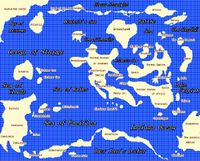Copenhagen
Copenhagen (Version 2.0, since the Vogons couldn't properly complete their work and now inhabit the city) is a former swedish city. It declared its independence in 1948, but because nobody cared, it was never accepted by the United Nations. Population estimated at 274.561 (1996 census), not counting garden gnomes. In 1998 the Copenhageners elected their first democratic government. The government is lead by president Klaus Bondam (a former member of ABBA)'s puppetmaster.
Urban planning and communication[edit | edit source]
Copenhagen was constructed on a cluster of artificial islands in the Baltic Sea after the city that used to be there, Tivoli was completely destroyed by Allied bombardments during WW2. Its innovative city plan, designed by M. C. Escher is based on the outline of a hyperbolic plane.
Because of heavy congestion charges, private automobiles are rare, and the primary mode of individual transport is horocycles and rickshaw.
In the outskirts of Copenhagen Broendby Stadium is situated. It is made out matchsticks and old lego. The cleaver observer will be able to se a very close resemlance to East Berlin. This is no coinsidance. They were built simutaniusly - and are nearly identicle. The only difference is that the Germans used wett turf to glue the place together, whilst the slaved labour used earwax to glue Broendby Stadium together (they had obtained glue from nearby kindergarden, but they used it all up on their way back........). In Denmark turf is only used to conservate funny brown men.
Demographics[edit | edit source]
The large ethnic minority populations in the city (Roma, Kurds, Wheys, Icelanders, Vogons) live mainly on colourfully painted canal boats, many of them tied together with old hawser and scarves. Violent confrontations have occurred when these have come undone and they drifted into the wrong canal. Disoriented by streetscapes facing the wrong direction and strange-smelling foreign lagers wafting over the gunwales, they jump up and down on one end of the opposing canal boat until it starts to list and all the geraniums in pots slide down into the choppy waters of the canal. Copenhagen is thus the only city in Europe that has more geraniums growing underwater than above ground.
Notable industries[edit | edit source]
The main legitimate industry in Copenhagen is tourism (the tourist board famously postulates that "this city has no parallel"). In practice it is, however, overshadowed by a large underground economy involving government and other forms of organized crime.
The most well-known business operating out of Copenhagen is probably The Little Sperm-Aid, Europe's second largest online-pharmacy, whose imposing domicile dominates the harbourfront.
The people of Copenhagen all have luxurious hair growing from between their teeth, and on special occasions eat the traditional roasted baby at traditional Viking get-togethers.
More recently, the mayor of Copenhagen just solved the Swedish-Danish crisis, by trading Malmö for the Iranian nuclear programme. This way neither Denmark or Sweden has to recognise Malmö. It has simply been cut out and shipped away, the magnificent Øresund bridge has been extendended a bit though.
Superstitious Subjectivist Nonsense[edit | edit source]
The Copenhagen Interpretation of Quantum Mechanics, a leading provider of real-time translation services for multilingual scientific conventions, is actually not headquartered in Copenhagen, but located in Pasadena, California. Various Copenhagen mayors (most prominently Danny Kaye) have tried suing the crap out of them for "sullying the name of a beautiful city with superstitious subjectivist nonsense", but these lawsuits have so far been unsuccessful, primarily because the Copenhagen Interpretation was founded in the 1920s when nobody was looking, decades before the city itself.
Name[edit | edit source]
The city is named after a gold prospector from Quebec, Joe Juneau, though the place was for a time called Rockwell and then Harrisburg (after Juneau's co-prospector, Richard Harris). The Tlingit name of the town is Dzántik'i Héeni ("Base of the Flounder’s River," dzánti ‘flounder,’ –kʼi ‘base,’ héen ‘river’), and Auke Bay just north of Juneau proper is called Áak'w ("Little lake," áa ‘lake,’ -kʼ ‘diminutive’) in Tlingit. The Taku River, just south of Juneau, was named after the cold t'aakh wind, which occasionally blows down from the mountains.

